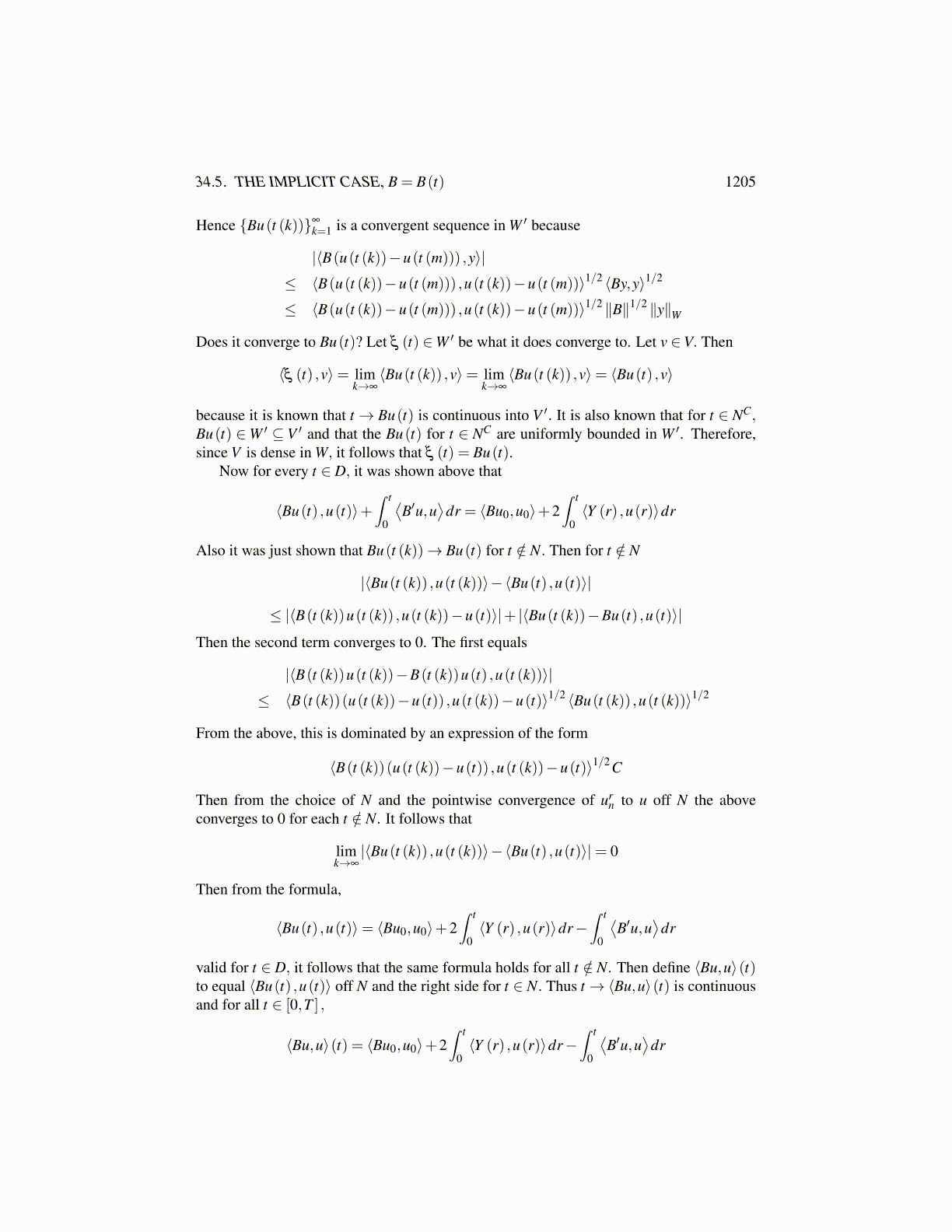
34.5. THE IMPLICIT CASE, B = B(t) 1205
Hence {Bu(t (k))}∞
k=1 is a convergent sequence in W ′ because
|⟨B(u(t (k))−u(t (m))) ,y⟩|≤ ⟨B(u(t (k))−u(t (m))) ,u(t (k))−u(t (m))⟩1/2 ⟨By,y⟩1/2
≤ ⟨B(u(t (k))−u(t (m))) ,u(t (k))−u(t (m))⟩1/2 ∥B∥1/2 ∥y∥W
Does it converge to Bu(t)? Let ξ (t) ∈W ′ be what it does converge to. Let v ∈V. Then
⟨ξ (t) ,v⟩= limk→∞
⟨Bu(t (k)) ,v⟩= limk→∞
⟨Bu(t (k)) ,v⟩= ⟨Bu(t) ,v⟩
because it is known that t → Bu(t) is continuous into V ′. It is also known that for t ∈ NC,Bu(t) ∈W ′ ⊆ V ′ and that the Bu(t) for t ∈ NC are uniformly bounded in W ′. Therefore,since V is dense in W, it follows that ξ (t) = Bu(t).
Now for every t ∈ D, it was shown above that
⟨Bu(t) ,u(t)⟩+∫ t
0
⟨B′u,u
⟩dr = ⟨Bu0,u0⟩+2
∫ t
0⟨Y (r) ,u(r)⟩dr
Also it was just shown that Bu(t (k))→ Bu(t) for t /∈ N. Then for t /∈ N
|⟨Bu(t (k)) ,u(t (k))⟩−⟨Bu(t) ,u(t)⟩|
≤ |⟨B(t (k))u(t (k)) ,u(t (k))−u(t)⟩|+ |⟨Bu(t (k))−Bu(t) ,u(t)⟩|
Then the second term converges to 0. The first equals
|⟨B(t (k))u(t (k))−B(t (k))u(t) ,u(t (k))⟩|≤ ⟨B(t (k))(u(t (k))−u(t)) ,u(t (k))−u(t)⟩1/2 ⟨Bu(t (k)) ,u(t (k))⟩1/2
From the above, this is dominated by an expression of the form
⟨B(t (k))(u(t (k))−u(t)) ,u(t (k))−u(t)⟩1/2 C
Then from the choice of N and the pointwise convergence of urn to u off N the above
converges to 0 for each t /∈ N. It follows that
limk→∞
|⟨Bu(t (k)) ,u(t (k))⟩−⟨Bu(t) ,u(t)⟩|= 0
Then from the formula,
⟨Bu(t) ,u(t)⟩= ⟨Bu0,u0⟩+2∫ t
0⟨Y (r) ,u(r)⟩dr−
∫ t
0
⟨B′u,u
⟩dr
valid for t ∈ D, it follows that the same formula holds for all t /∈ N. Then define ⟨Bu,u⟩(t)to equal ⟨Bu(t) ,u(t)⟩ off N and the right side for t ∈ N. Thus t→ ⟨Bu,u⟩(t) is continuousand for all t ∈ [0,T ] ,
⟨Bu,u⟩(t) = ⟨Bu0,u0⟩+2∫ t
0⟨Y (r) ,u(r)⟩dr−
∫ t
0
⟨B′u,u
⟩dr